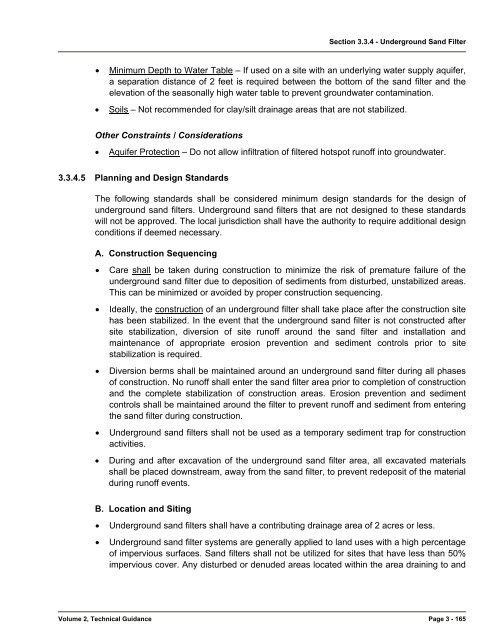Volume 2-05, Chapter 3 - City of Wichita
Volume 2-05, Chapter 3 - City of Wichita
Volume 2-05, Chapter 3 - City of Wichita
Create successful ePaper yourself
Turn your PDF publications into a flip-book with our unique Google optimized e-Paper software.
Section 3.3.4 - Underground Sand Filter<br />
• Minimum Depth to Water Table – If used on a site with an underlying water supply aquifer,<br />
a separation distance <strong>of</strong> 2 feet is required between the bottom <strong>of</strong> the sand filter and the<br />
elevation <strong>of</strong> the seasonally high water table to prevent groundwater contamination.<br />
• Soils – Not recommended for clay/silt drainage areas that are not stabilized.<br />
Other Constraints / Considerations<br />
• Aquifer Protection – Do not allow infiltration <strong>of</strong> filtered hotspot run<strong>of</strong>f into groundwater.<br />
3.3.4.5 Planning and Design Standards<br />
The following standards shall be considered minimum design standards for the design <strong>of</strong><br />
underground sand filters. Underground sand filters that are not designed to these standards<br />
will not be approved. The local jurisdiction shall have the authority to require additional design<br />
conditions if deemed necessary.<br />
A. Construction Sequencing<br />
• Care shall be taken during construction to minimize the risk <strong>of</strong> premature failure <strong>of</strong> the<br />
underground sand filter due to deposition <strong>of</strong> sediments from disturbed, unstabilized areas.<br />
This can be minimized or avoided by proper construction sequencing.<br />
• Ideally, the construction <strong>of</strong> an underground filter shall take place after the construction site<br />
has been stabilized. In the event that the underground sand filter is not constructed after<br />
site stabilization, diversion <strong>of</strong> site run<strong>of</strong>f around the sand filter and installation and<br />
maintenance <strong>of</strong> appropriate erosion prevention and sediment controls prior to site<br />
stabilization is required.<br />
• Diversion berms shall be maintained around an underground sand filter during all phases<br />
<strong>of</strong> construction. No run<strong>of</strong>f shall enter the sand filter area prior to completion <strong>of</strong> construction<br />
and the complete stabilization <strong>of</strong> construction areas. Erosion prevention and sediment<br />
controls shall be maintained around the filter to prevent run<strong>of</strong>f and sediment from entering<br />
the sand filter during construction.<br />
• Underground sand filters shall not be used as a temporary sediment trap for construction<br />
activities.<br />
• During and after excavation <strong>of</strong> the underground sand filter area, all excavated materials<br />
shall be placed downstream, away from the sand filter, to prevent redeposit <strong>of</strong> the material<br />
during run<strong>of</strong>f events.<br />
B. Location and Siting<br />
• Underground sand filters shall have a contributing drainage area <strong>of</strong> 2 acres or less.<br />
• Underground sand filter systems are generally applied to land uses with a high percentage<br />
<strong>of</strong> impervious surfaces. Sand filters shall not be utilized for sites that have less than 50%<br />
impervious cover. Any disturbed or denuded areas located within the area draining to and<br />
<strong>Volume</strong> 2, Technical Guidance Page 3 - 165
















